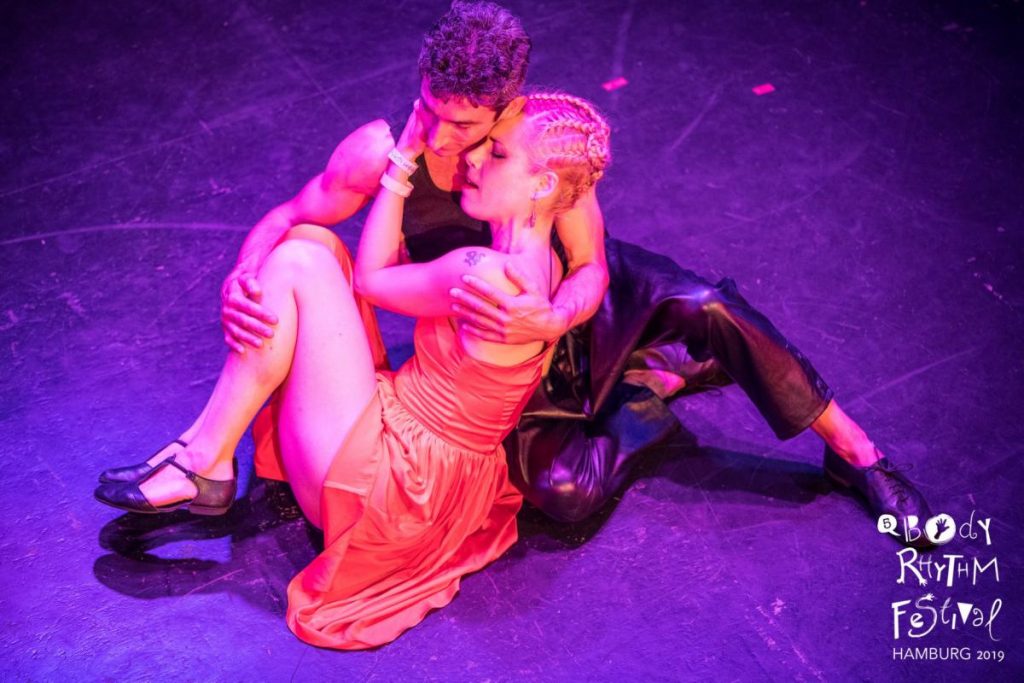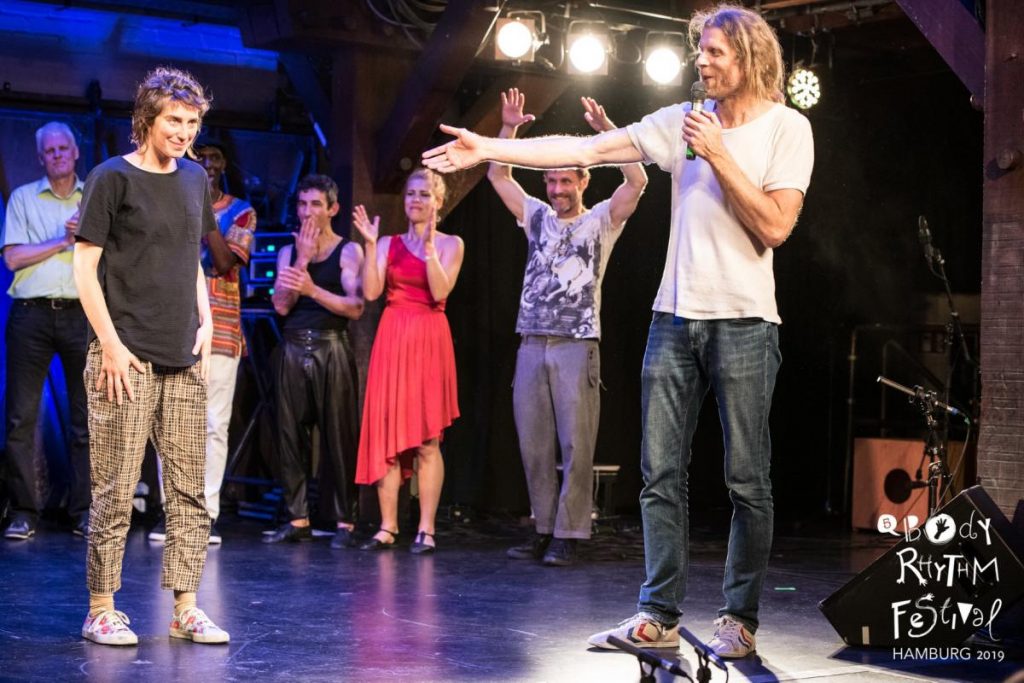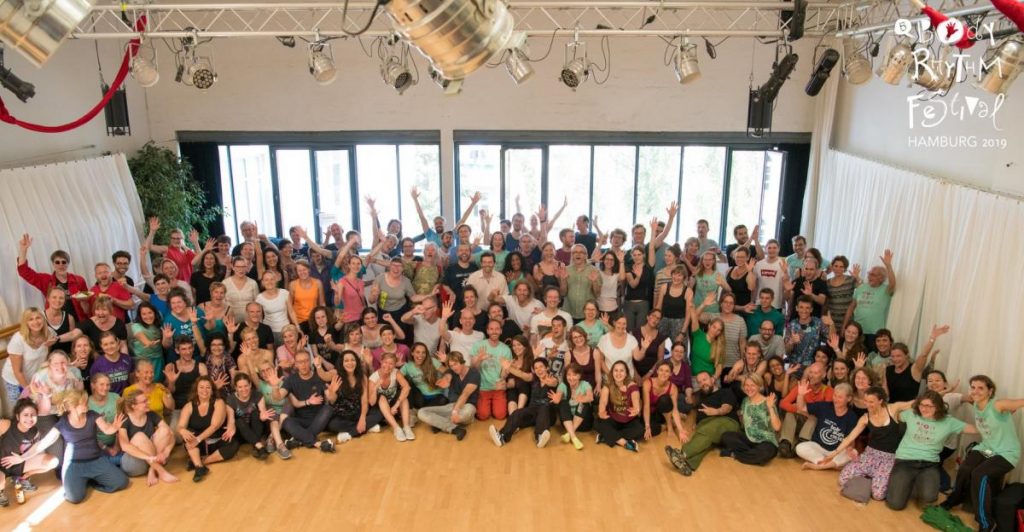Every time you return somewhere, it is like coming back home. Body Rhythm festival is a time and place we are striving for.
Hamburg, the big harbor, capital of travelers, hasn’t changed a day for me since I visited it last year. My partner Marko and me are greeted with sun and incredibly hot June. It is great, after rain and this year’s spring that was actually more like autumn and the air conditioning and cool night we experienced on the bus. Solving usual travelers’ tasks of finding a safe port to cast an anchor for a short time, we find a cafe with a view of a sunny, busy street in the center. We gaze in the a stream of people walking and chewing their breakfast, while a river of cars is passing them.
After a short creative meeting, we pull our suitcases to a bench near a church, to record a short Instagram video clip. We connect two events that have only us in common: a theater festival happening in the forest of Fruska gora in Serbia and an international festival of body percussionists in Hamburg.
Hajde (Serbian for Come on/let’s do it, the name of the festival in the forest), the leitmotif of the day arise from the video clip we record. Dare again to come to Hamburg! Figure out what is awaiting for you in the big world and small community of people that share your passion for body music, movement, making music in groups, improvising. Find the happy moment in which you find theonly possible musical solution for the time that is now. Meet people you know, but changed after a year of their lives. Feel happiness because of the reunion and the suspense you feel before the four precious days that have changed your life last year.
Opening night of Body Rhythm Festival
The concert, the traditional opener of the festival, was the performance of two Danish artists: Peter Stavrum Nielsen and Rune Thorsteinsson. They both have impressive biographies. The first is a drummer that performed with STOMP for over a decade. The second a multi instrumentalist, performer and composer. Together they created the Body Rhythm Factory, awarded with the YAM Award for the best music production for children and youth in 2013.
They are very natural on stage and incredibly funny: while Thorsteinsson plays Spanish motifs on an upright piano without the front cover, occasionally playing on strings with his fingers, Stavrum stomps with fantastic agility, claps, turns, moans, groans, sings, beat-boxes. He turns his whole body into an instrument and firecracker of sounds, and then brings the audience into climax playing on rubber piggies of different sizes (and pitches) and rubber rooster he tunes changing the opening of his beak. At the same time completely bizarre and hilariously funny, as if John Klees has been crossbred with Franz Liszt! Than gentle, melancholic melodies of Thorsteinsson in Danish, while Stavrum plays on the aquarium splashing and decanting water and spreading the body music to the body of the whole world.
In front of the club in the yard, we whisper, not to disturb the inhabitants of the buildings around us. Carried away by the energy of the reunion we constantly try to hush down the others but are too noisy ourselves. We laug like children on a school break. It is still dusk, although it is 10 PM, so we need to get used to the north and different understanding of the daylight. We come back to the Bewegungswelten Studios while chit chatting. This place will be our home for the next four days and also the center of our small world.
Engaging youth in body music with Serratosa
Rhythm Choreographies and Rhythm Pedagogy are workshops led by Santi Serratosa, a Spanish drummer, pedagogue and (body) percussionist. By playing games he develops rhythmical matrix connected with movements that are performed in one circle, where left and right “neighbors” are partners. We also play in two circles, the inside and the outside one, where we change partners, as circles are rotated in opposite directions.
Rhythmical patterns and movements are complex, based on dissociation, movement and changing of sides. When we learn and develop choreography, Serratosa plays modern dance music. This does not make my ears happy, but it goes very nicely with this rhythmical dance. Participants accept it with humor. At the end of the workshop, talking, we learn that this is orientated for work with youth. The point is to make a safe environment they recognize. The unfamiliar elements, body percussion and movement, and the familiar one blend. The movement takes all of their attention. They engage in communication and go out of the comfort zone. It is like a meditation in movement, where participants are present here and now. This happens very seldom in everyday life.
Cuban music master
Next, we are in the hands of a master, an Austrian living in New York, Max Pollack. This artist communicates with the same ease with thousands of people in the audience in Minnesota, playing side by side with symphony orchestra, and with about 40 participants of the workshop in the biggest studio. His workshop Odd meters and clave is focused on Cuban music. The emphasis is on the feet and stomping and clapping in a very particular way. Clave are wooden sticks of African origin.
We learn rhythmical patterns characteristic for cascara and tumba, building a rhythmical orchestra that pulses in rhythm of ten beats. Like a mantra, it erases the border of the beginning and end of the phrase. You stop counting and start simply being, while moving, dancing and playing music.
We sing Un golpecito, na’ mas (just one little beat, nothing more). It is a tribute to Horacio ‘El Negro’ Hernandez, a drummer from Cuba that played with musicians like Santana. His creation is strongly rooted in Cuban heritage on which he bases his own expression. What is contemporary in this musical model is that one beat more, and it makes it very unusual to comprehend and perform, with all syncopation Cuban music already has. After three hours workshop it seems to me I know less than I knew before, but being discouraged can be cured by resting.
Open stage party at Body Rhythm festival
But, alas, not yet! The rest will come after the Open stage party, where we present our project RikaTaka, the new Balkan rhythm with the North Macedonian folk song Teach me, mother, scold me (Uči me, majko, karaj me). The trait we can offer to this versatile international group of people is Balkan folk music with its odd rhythms. In the West, odd rhythms are performed as in the language of jazz, never with an accent and the temperament of the people from the Balkans.
An hour before the Open stage (and 15 minutes after the last workshop for the day) we have a first (and the last) rehearsal with Zarina Kogay and Alex Ostapenko for a piece we will perform together. They have made an arrangement as a tribute to the work of Peter Stavrum Nielsen, and we’ve made some tunes.
On the Open stage there are various artists. Martina Jordan sings an ancient Swedish song combining it with the ancient Turkish rhythm, Usul, of 60 measures (which reminds me of Indian rhythm loops that are kilometers in length). Sophie Boucher performs a part from a fantastic music theater show Soleo, that tells a tale by movement and music of a contemporary man’s life, work on an assembly line in a factory. Mattias Wyss and Corinne Schmidiger from Switzerland perform their musical arrangement of Box from Deejay Young, jazzy and pop, light, but about not putting people in boxes and classifications. Swedish duo Peter Lagergren and Conny Jansson dance, sing and make us laugh until we cry with their seriousness. Anselmo Luisi does a mixture of comedia dell’ arte, clowning, beat boxing and body percussion performance, telling a story while performing all the characters. The specially emotional moment is when two sisters, musicians, Celina Bostic and Sarah Lazaki perform for the first time the cannon Bostic has written – again a little workshop, right on the stage! The variety of ideas and approaches are made even with the overwhelming applause of the audience.
Diving deeper into the body music rhythm
After my morning yoga, I start the second day with the workshop Games, Improv and Beats of Stavrum Nielsen. He is as funny and inventive with the participants as on stage. Firstly, he lets the participants meet and communicate in order to make the group made of people on different levels of knowledge and skills homogeneous. There are people here from 20 to 70 years old! I am fascinated by the social aspect of body music. There is no competition, just like a real Boal social theater group. Including every single participant in the group is making it possible for the person to offer and give what she/he can. I am sure that the spirit and way of thinking is also influenced by the great Fernando Barba, founder of Barbatuques.
By playing and adding a piece by piece, one small rhythmical element, we construct a sophisticated rhythmical sequence. I observe the less experienced participants and recognize the same surprise and enchantment in their facial and bodily expressions that were also mine, when I started to do body music. In the beginning of the workshop they were newborns, carefully making every step, sometimes ahead or after the beat. Now they are performing something that was an hour and a half ago so distant from them as the Earth from the Moon.
The Body Rhythm festival show
And now something Marko and I were waiting for impatiently ever since we found out about it: our performance on the Festival show, on the same stage with the workshop leaders. This people we admire: Sarah Lazaki (one more performer of STOMP) and Ben Schuetz (the founder of the festival, a man of steady, floating energy, whose workshops are gentle and cuddling), Charles Raszl (member of the Barbatuques, a body percussionist rooted in Brazilian tradition and capoeira, that moves like he is dancing on air), Anna Llombart (a dancer and body percussionist from Spain, a burning fire on stage), singers from Holland gathered around Kees Kool, that were teaching vocal painting workshop, structured improvisation leaded by characteristic signs.
In the backstage, I am very eager to go on stage, feeling impatient. And on the stage I feel we are just where we belong: here we are not weird, freaks, hopping around, hitting ourselves and singing, but interesting because of artistic novelty. We perform Brother and sister, a Croatian folk song, and Ergen dedo, a song from Bulgaria. The musical arrangement of Ergen dedo is inspired by a workshop of konnakol by Alex Ostapenko we attended last year. This is just one more way this festival has intruded our hearts and minds and made us grow and develop. The last number is our own song. The audience claps enthusiastically, and Marko and me go off the stage with gratitude and warmth in our hearts.
Taketina experience
The last workshop I attend is Taketina, lead by Esther Diethelm from Switzerland. The experience like no other, because it is led with an intention of throwing the contemporary individual out of the ego trip by – music. Dissociation of movement and attention, poly-rhythms, in the same time playing different rhythms with hands (claps), feet (stomp) and voice with accents on unusual places.
This is how it is done: right hand of the co-leader Joachim Münster plays surdo drum and accents the base beat. Esther Diethelm plays the second rhythm on berimbau and assigns the melody as a call that participants answer to, trying to repeat it. The feet follow the surdo drum, the hands berimbau. It all sounds completely simple and easy while listening. When you participate, it becomes clear how complicated is the polyphony of three rhythm and melody lines of different beats and accents.
After fifteen minutes we all are in a state of mild trance, because we stop thinking and let go to the intuitive repetition. We succeed, then we fail, and this roller coaster of learning repeats without a fault, following the capacity of our attention or rather our capability to let go. At the moment we quit controlling and decide to believe the impossible the synchronicity happens. Counting doesn’t help at all, neither does ratio, or just a little. Very fast ratio stops being capable of answering the task, because of the lack of capacity. After an hour and a half we all lay down into something that resembles yoga nidra at the end of a yoga class: the feeling is pretty much the same, we don’t need to explain, we just want to BE.
Goodbye for now, Body Rhythm festival
All the participants meet at The Final Jam, where we are split into four groups led by the teachers and the festival producers Ben Schuetz and Detlef von Boetticher. They give different musical themes we play looping, and then the leaders change, the next one coming out of the group. All the leaders are inspired: some of them jump, moving through space of the big studio in a line, some sing. Others do onomatopoeic sounds, texts, all of them using some form of body percussion.
It is very challenging to be in front of the group and face your zest, enthusiasm, ideas and limitations. The leader also needs to be aware of the capabilities of the participants, speed of reaction, the complexity of what we set as a musical theme, that group loops and doesn’t change until we set a different pattern, following every hint of the conductor and composer. We finish with appeasement, softly singing the Teacher’s song, one more of the rituals of the festival. It is a new song that is performed at the end of Festival show and that closes every festival, being a constant reminder of all the experiences the next few days. It still plays in the minds of the participants, echoing the festival in next weeks.
Life changing experience and insights
The next morning we are the last ones to leave Bewegungswelten Studios, the venue that hosts the festival every year. Andreas Klupp, the host in the studio and festival support in all possible ways, shares breakfast with us.
Already tomorrow we have a performance at the Serbian National Theater in Novi Sad, last in this season, in the place where the new artistic expressions have a place to manifest. I feel fortunate and full: the last four days have, again, changed my life; I feel support to believe in my own story, different from all the others. Also I find confirmation that, even with great differences, the togetherness exists. That in this world, people can, without too many words and ado, still understand each other, get along and live together.
Written and translated by Ana Vrbaški
Many thanks to Kristina Ivsic and Ben Schuetz for all suggestions and corrections in the text.
Body Rhythm Festival
Youtube
https://www.bodyrhythm.de
https://web.facebook.com/bodyrhythmhamburg/
Photographs by Georg Tedeschi
https://www.georgtedeschi.com/






